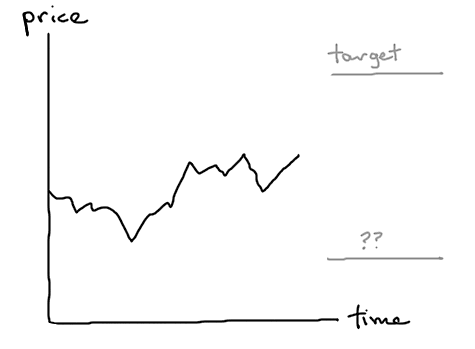
- Wednesday, January 6th, 2010
- the error price
-
One staple of the investment research game is the target price, that device for indicating where a stock will trade at some future time. Usually a data item on a research report, it can be visualized as well:
 But wait, another line has been added. What shall we call it? I always refer to it as “the error price,” although analysts never have any idea what I’m talking about when I do. Research is mostly a game of “how high,” with little time spent on understanding risks, and no term has come into common usage to describe the concept I feature here.
But wait, another line has been added. What shall we call it? I always refer to it as “the error price,” although analysts never have any idea what I’m talking about when I do. Research is mostly a game of “how high,” with little time spent on understanding risks, and no term has come into common usage to describe the concept I feature here.But before we look at that bottom line, let’s look at the top one. If you find yourself in front of a Bloomberg machine or the like, you can see how the average target price for a given stock has varied over time. Certainly some quantitative genius has found a way to integrate that series with other information into a profit-making stew, but it’s hard to find a mushier data series than that one. That said, as with earnings estimates, seeing analysts leapfrog one another (up or down) with their target prices can provide some important clues as to the flow of attention and money (especially if you recognize a trend early), since those behavioral square dances tend to last for awhile.
In fact, target prices are best understood as marketing tools rather than analytical ones. Despite decades of related folly, it’s amazing how the notion that target prices matter lingers on. The charade is a bit muted right now, although the bounce off of the bottom has brought it back somewhat. When the animal spirits return in force, you can bet we’ll see fantasy numbers thrown around again (with the media circus featuring them in the center ring).
While some research firms are good about enforcing a measure of discipline in the target prices that appear under their banners, others are not. Practice is all over the map, which makes the notion of an average of target prices pretty ridiculous. Where, exactly, is the target time to go with the target price? Why, precisely, should the stock reach it, in terms of fundamentals and valuation? What, specifically, are the two or three things that have to happen for that to all come together? How much, do you suppose, will the market be up in the meantime?
To the last point: The dirty little secret of this whole game is that by looking at the target price you can’t separate stock-specific expectations from the inexorable grinding of the wheels of Finance 101. You’re buying a stock and expect it to give you some kind of return commensurate with the risk you are taking. An unsuspecting user of a research report can see a target price up twelve percent and think it looks pretty good, while it might represent too low an expected return for the risks undertaken. The pieces of the puzzle are hidden unnecessarily.
A single-point error price would have many of the same problems as the single-point target price does, but including it in an analysis is the first step toward a much better framework for decision making, by simply acknowledging the existence of the other side of the distribution of outcomes. Of course, the range of possibilities is even wider than the brackets provided by the target and error prices, but two markers are better than one in plotting a course of action.
Those looking to sell you something might not like to admit it, but they are occasionally wrong. As I wrote elsewhere recently, “The economic world is one of uncertainty rather than certainty, and no amount of bluster can change that.”tjb advisors | The quote referred to those that play the new-year forecasting game; it comes from the current newsletter for my investment advisory business. (It is published every couple of weeks via email if you have an interest in signing up.) It would be nice if the tools of our trade acknowledged that fact.
